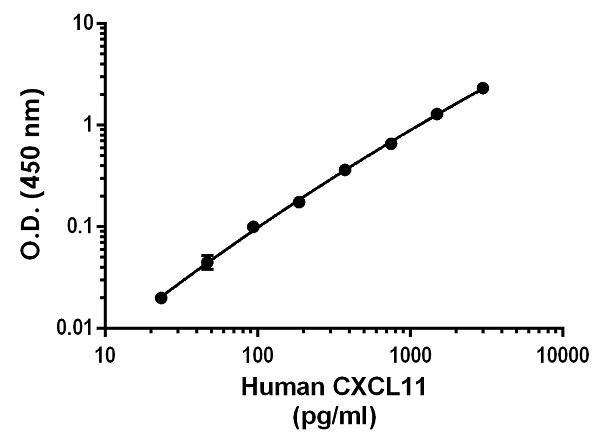Human CXCL11 ELISA Kit (I-TAC) (ab187392)
Key features and details
- One-wash 90 minute protocol
- Sensitivity: 1 pg/ml
- Range: 46.88 pg/ml - 3000 pg/ml
- Sample type: Cell culture supernatant, Cit plasma, EDTA Plasma, Hep Plasma, Serum
- Detection method: Colorimetric
- Assay type: Sandwich (quantitative)
- Reacts with: Human
Overview
-
Product name
Human CXCL11 ELISA Kit (I-TAC)
See all CXCL11 kits -
Detection method
Colorimetric -
Precision
Intra-assay Sample n Mean SD CV% Overall 8 4.6% Inter-assay Sample n Mean SD CV% Overall 3 11.3% -
Sample type
Cell culture supernatant, Serum, Hep Plasma, EDTA Plasma, Cit plasma -
Assay type
Sandwich (quantitative) -
Sensitivity
1 pg/ml -
Range
46.88 pg/ml - 3000 pg/ml -
Recovery
Sample specific recovery Sample type Average % Range Serum 120 115% - 129% Cell culture media 98 91% - 102% Hep Plasma 112 108% - 115% EDTA Plasma 90 80% - 99% Cit plasma 80 76% - 85% -
Assay time
1h 30m -
Assay duration
One step assay -
Species reactivity
Reacts with: Human -
Product overview
Human CXCL11 ELISA Kit (I-TAC) (ab187392) is a single-wash 90 min sandwich ELISA designed for the quantitative measurement of CXCL11 (I-TAC) protein in cell culture supernatant, cit plasma, hep plasma, serum, and edta plasma. It uses our proprietary SimpleStep ELISA® technology. Quantitate Human CXCL11 (I-TAC) with 1 pg/ml sensitivity.
SimpleStep ELISA® technology employs capture antibodies conjugated to an affinity tag that is recognized by the monoclonal antibody used to coat our SimpleStep ELISA® plates. This approach to sandwich ELISA allows the formation of the antibody-analyte sandwich complex in a single step, significantly reducing assay time. See the SimpleStep ELISA® protocol summary in the image section for further details. Our SimpleStep ELISA® technology provides several benefits:
- Single-wash protocol reduces assay time to 90 minutes or less
- High sensitivity, specificity and reproducibility from superior antibodies
- Fully validated in biological samples
- 96-wells plate breakable into 12 x 8 wells stripsA 384-well SimpleStep ELISA® microplate (ab203359) is available to use as an alternative to the 96-well microplate provided with SimpleStep ELISA® kits.
-
Notes
CXCL11 (I-TAC) is a chemokine for interleukin-activated T-cells but not unstimulated T-cells, neutrophils or monocytes. CXCL11 expression is strongly unregulated in response to IFN-gamma. It has been shown to induce calcium release in activated T-cells and bind to the cellular receptor CXCR3. CXCL11 may play an important role in CNS diseases which involve T-cell recruitment and in skin immune responses.
-
Platform
Microplate
Properties
-
Storage instructions
Store at +4°C. Please refer to protocols. -
Components 1 x 96 tests 10X Human CXCL11 Capture Antibody 1 x 600µl 10X Human CXCL11 Detector Antibody 1 x 600µl 10X Wash Buffer PT (ab206977) 1 x 20ml Antibody Diluent 5BI 1 x 6ml Human CXCL11 Lyophilized Recombinant Protein 2 vials Plate Seals 1 unit Sample Diluent 25BS 1 x 20ml Sample Diluent NS (ab193972) 1 x 50ml SimpleStep Pre-Coated 96-Well Microplate (ab206978) 1 unit Stop Solution 1 x 12ml TMB Development Solution 1 x 12ml -
Research areas
-
Function
Chemotactic for interleukin-activated T-cells but not unstimulated T-cells, neutrophils or monocytes. Induces calcium release in activated T-cells. Binds to CXCR3. May play an important role in CNS diseases which involve T-cell recruitment. May play a role in skin immune responses. -
Tissue specificity
High levels in peripheral blood leukocytes, pancreas and liver astrocytes. Moderate levels in thymus, spleen and lung. Low levels in placenta, prostate and small intestine. Also found in epidermal basal layer keratinocytes in skin disorders. -
Sequence similarities
Belongs to the intercrine alpha (chemokine CxC) family. -
Cellular localization
Secreted. - Information by UniProt
-
Alternative names
- b R1
- b-R1
- Beta-R1
see all -
Database links
- Entrez Gene: 6373 Human
- Omim: 604852 Human
- SwissProt: O14625 Human
- Unigene: 632592 Human
Images
-
SimpleStep ELISA technology allows the formation of the antibody-antigen complex in one single step, reducing assay time to 90 minutes. Add samples or standards and antibody mix to wells all at once, incubate, wash, and add your final substrate. See protocol for a detailed step-by-step guide.
-
Example of CXCL11 standard curve in Sample Diluent 25BS. Background-subtracted data values (mean +/- SD) are graphed.
-
Observed CXCL11 levels in individual donor normal Human serum (n=10). Mean Human CXCL11 is 131 pg/mL and values fall within expected normal reference ranges (WHO).
-
THP-1 cells were cultured in RPMI supplemented with 10% fetal calf serum, 2 mM L-glutamine, 100 U/mL penicillin, and 100 µg/mL streptomycin. Cells were stimulated for 8 hours with or without 1 µg/mL of human IFN-gamma recombinant protein. An aliquot of supernatant was removed and assayed for native CXCL11 protein levels. The concentrations of CXCL11 were interpolated from the calibration curve and corrected for sample dilution. The mean CXCL11 level was 58 pg/mL in untreated cells and 9,624 pg/mL in IFN-gamma treated cells.
-
Human peripheral blood cells (1x106 cells/mL) were cultured in RPMI media supplemented with 10% fetal calf serum, 100 U/mL penicillin, and 100 mg/mL streptomycin sulfate. Cells were cultured unstimulated or stimulated with 10 mg/mL PHA. Conditioned media was harvested after 48 hours, aliquoted and assayed for endogenous CXCL11 levels.
-
Observed CXCL11 levels in pooled donor normal Human plasma. Mean Human CXCL11 values fall within expected normal reference ranges (WHO).
-
Titration of cell culture supernatant from THP-1 cells stimulated with IFN-gamma within the working range of the assay. Background-subtracted data values (mean +/- SD, n = 3) are graphed.
-
Example of CXCL11 standard curve in Sample Diluent NS. Background-subtracted data values (mean +/- SD) are graphed.





















